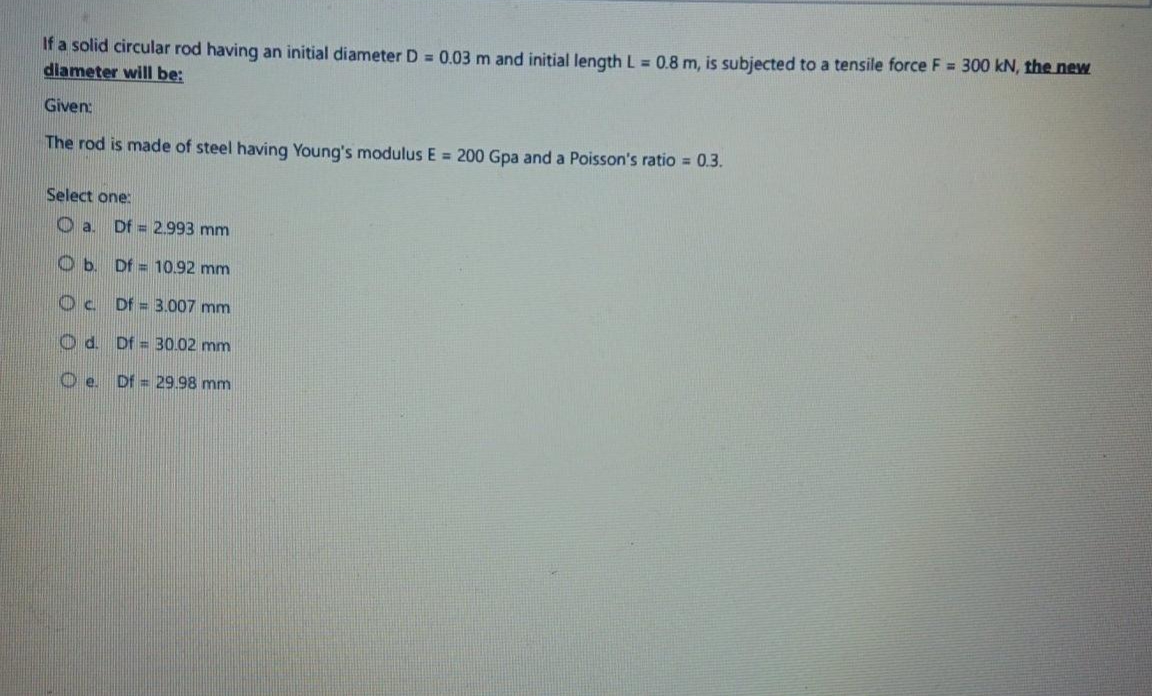If a solid circular rod having an initial diameter D = 0.03 m and initial length L = 0.8 m, is subjected to a tensile force F = 300 kN, the new diameter will be: Given: The rod is made of steel having Young's modulus E = 200 Gpa and a Poisson's ratio = 0.3. Select one: Oa. Df = 2.993 mm O b. O c. O d. Oe. Df = 10.92 mm Df= 3.007 mm Df= 30.02 mm Df = 29.98 mm
If a solid circular rod having an initial diameter D = 0.03 m and initial length L = 0.8 m, is subjected to a tensile force F = 300 kN, the new diameter will be: Given: The rod is made of steel having Young's modulus E = 200 Gpa and a Poisson's ratio = 0.3. Select one: Oa. Df = 2.993 mm O b. O c. O d. Oe. Df = 10.92 mm Df= 3.007 mm Df= 30.02 mm Df = 29.98 mm
Mechanics of Materials (MindTap Course List)
9th Edition
ISBN:9781337093347
Author:Barry J. Goodno, James M. Gere
Publisher:Barry J. Goodno, James M. Gere
Chapter2: Axially Loaded Members
Section: Chapter Questions
Problem 2.3.21P: A slightly tapered bar AB of solid circular crass section and length L is supported at end B and...
Related questions
Question

Transcribed Image Text:If a solid circular rod having an initial diameter D = 0.03 m and initial length L = 0.8 m, is subjected to a tensile force F = 300 kN, the new
diameter will be:
Given:
The rod is made of steel having Young's modulus E = 200 Gpa and a Poisson's ratio = 0.3.
Select one:
a. Df= 2.993 mm
Ob. Df = 10.92 mm
Oc. Df= 3.007 mm
Od. Df = 30.02 mm
Oe. Df = 29.98 mm
Expert Solution
This question has been solved!
Explore an expertly crafted, step-by-step solution for a thorough understanding of key concepts.
Step by step
Solved in 3 steps

Knowledge Booster
Learn more about
Need a deep-dive on the concept behind this application? Look no further. Learn more about this topic, mechanical-engineering and related others by exploring similar questions and additional content below.Recommended textbooks for you

Mechanics of Materials (MindTap Course List)
Mechanical Engineering
ISBN:
9781337093347
Author:
Barry J. Goodno, James M. Gere
Publisher:
Cengage Learning

Mechanics of Materials (MindTap Course List)
Mechanical Engineering
ISBN:
9781337093347
Author:
Barry J. Goodno, James M. Gere
Publisher:
Cengage Learning